Critical Reflection Paper: Child Trauma and its Impact on Development
VerifiedAdded on 2023/01/05
|8
|2232
|86
Report
AI Summary
This critical reflection paper examines the multifaceted issue of child trauma, drawing on various research articles to provide a comprehensive overview of its causes, effects, and potential interventions. The paper explores the impact of traumatic experiences on children, including the development of PTSD, depression, anxiety, and behavioral issues. It emphasizes the importance of trauma-informed care, diagnostic imaging, and creative arts therapies in addressing the psychological and emotional needs of traumatized children. The reflection highlights the significance of early intervention and the role of positive emotions, therapeutic relationships, and diagnostic tools in mitigating the long-term consequences of trauma. The paper also discusses the concept of complex trauma, its impact on self-regulation and social affiliation, and the need for comprehensive support systems for children and adolescents. Overall, the paper underscores the importance of understanding and addressing child trauma to promote healthy development and well-being. The author agrees with the proposed approaches and support the findings of the research papers and articles.
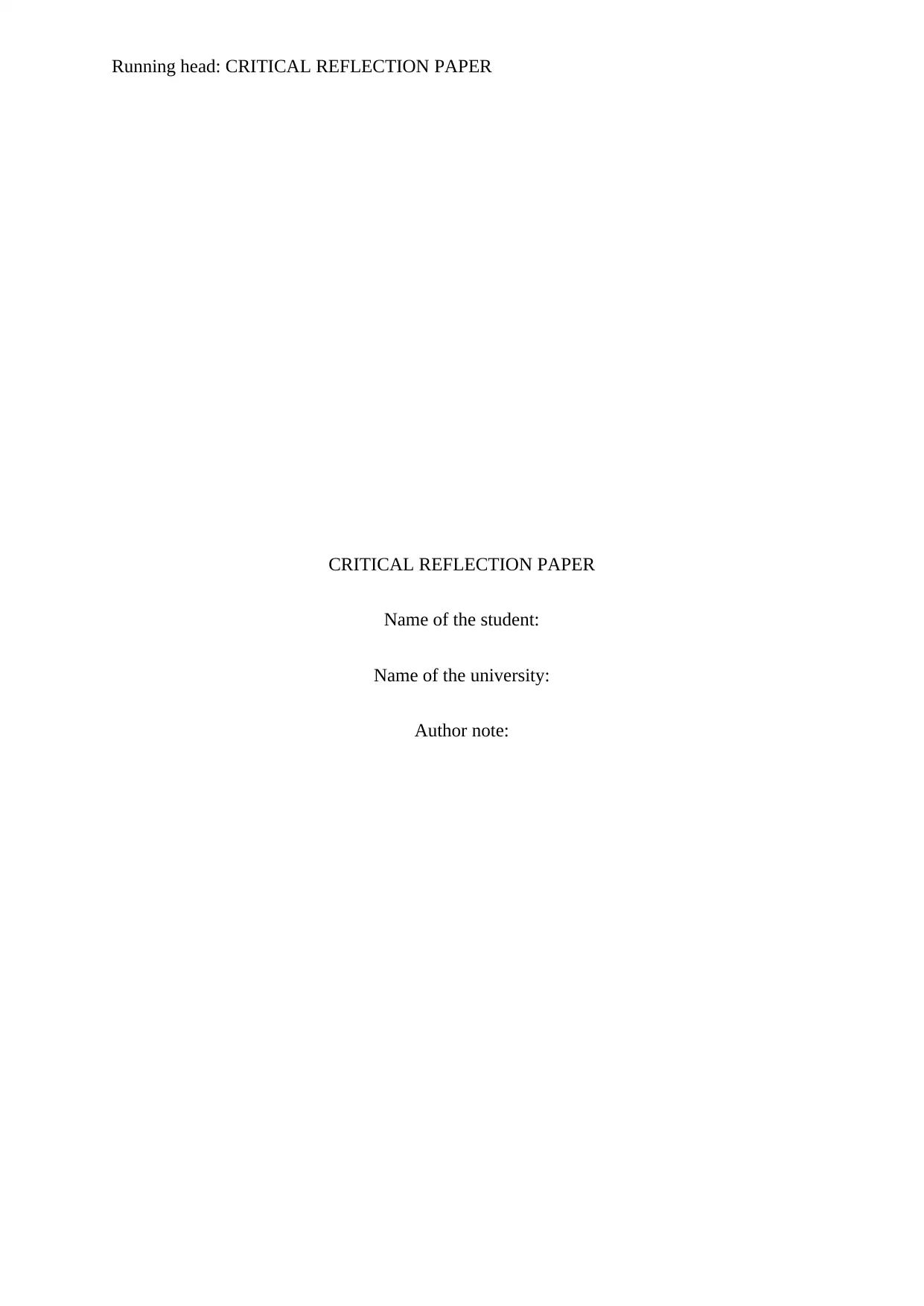
Running head: CRITICAL REFLECTION PAPER
CRITICAL REFLECTION PAPER
Name of the student:
Name of the university:
Author note:
CRITICAL REFLECTION PAPER
Name of the student:
Name of the university:
Author note:
Paraphrase This Document
Need a fresh take? Get an instant paraphrase of this document with our AI Paraphraser
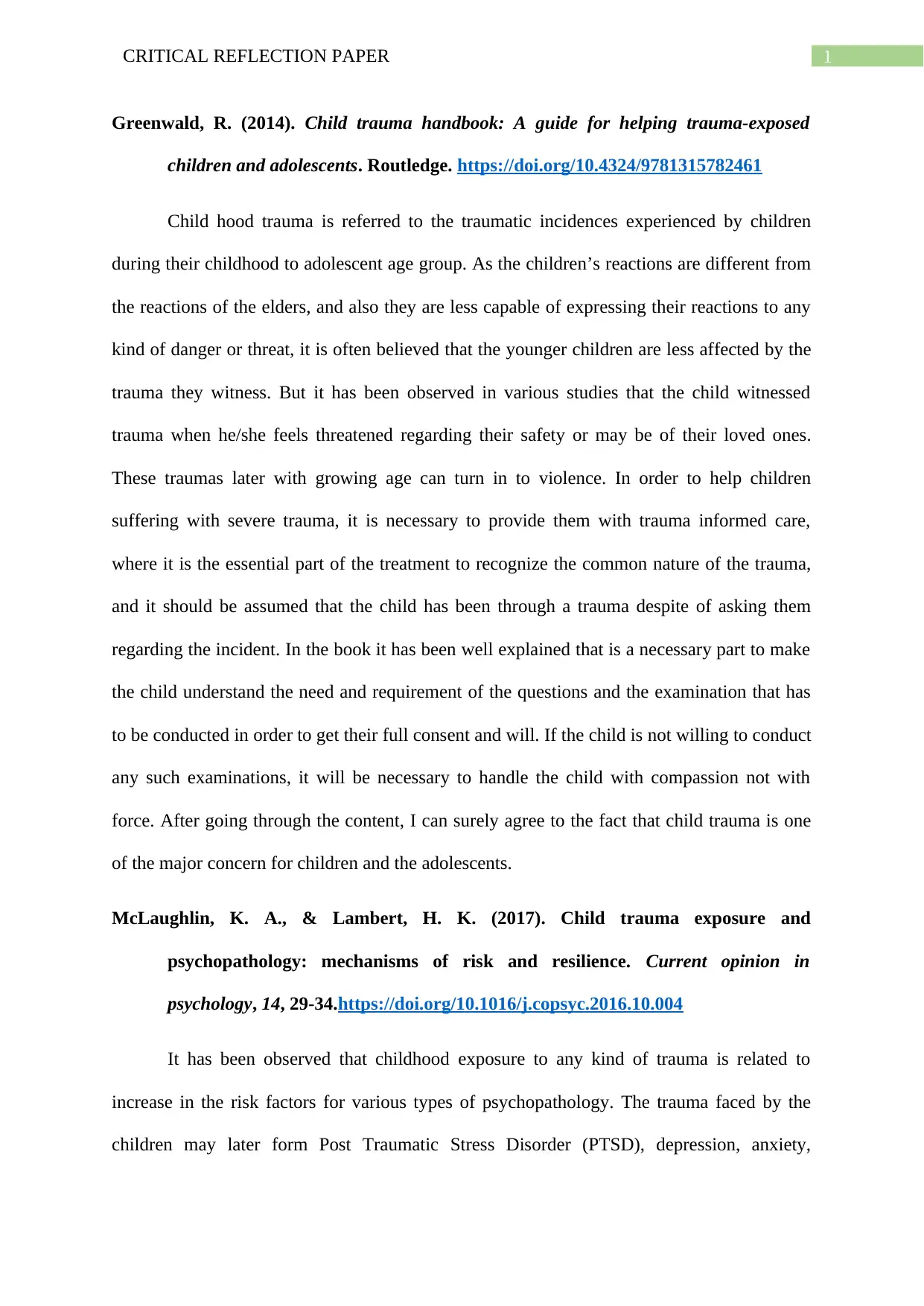
1CRITICAL REFLECTION PAPER
Greenwald, R. (2014). Child trauma handbook: A guide for helping trauma-exposed
children and adolescents. Routledge. https://doi.org/10.4324/9781315782461
Child hood trauma is referred to the traumatic incidences experienced by children
during their childhood to adolescent age group. As the children’s reactions are different from
the reactions of the elders, and also they are less capable of expressing their reactions to any
kind of danger or threat, it is often believed that the younger children are less affected by the
trauma they witness. But it has been observed in various studies that the child witnessed
trauma when he/she feels threatened regarding their safety or may be of their loved ones.
These traumas later with growing age can turn in to violence. In order to help children
suffering with severe trauma, it is necessary to provide them with trauma informed care,
where it is the essential part of the treatment to recognize the common nature of the trauma,
and it should be assumed that the child has been through a trauma despite of asking them
regarding the incident. In the book it has been well explained that is a necessary part to make
the child understand the need and requirement of the questions and the examination that has
to be conducted in order to get their full consent and will. If the child is not willing to conduct
any such examinations, it will be necessary to handle the child with compassion not with
force. After going through the content, I can surely agree to the fact that child trauma is one
of the major concern for children and the adolescents.
McLaughlin, K. A., & Lambert, H. K. (2017). Child trauma exposure and
psychopathology: mechanisms of risk and resilience. Current opinion in
psychology, 14, 29-34.https://doi.org/10.1016/j.copsyc.2016.10.004
It has been observed that childhood exposure to any kind of trauma is related to
increase in the risk factors for various types of psychopathology. The trauma faced by the
children may later form Post Traumatic Stress Disorder (PTSD), depression, anxiety,
Greenwald, R. (2014). Child trauma handbook: A guide for helping trauma-exposed
children and adolescents. Routledge. https://doi.org/10.4324/9781315782461
Child hood trauma is referred to the traumatic incidences experienced by children
during their childhood to adolescent age group. As the children’s reactions are different from
the reactions of the elders, and also they are less capable of expressing their reactions to any
kind of danger or threat, it is often believed that the younger children are less affected by the
trauma they witness. But it has been observed in various studies that the child witnessed
trauma when he/she feels threatened regarding their safety or may be of their loved ones.
These traumas later with growing age can turn in to violence. In order to help children
suffering with severe trauma, it is necessary to provide them with trauma informed care,
where it is the essential part of the treatment to recognize the common nature of the trauma,
and it should be assumed that the child has been through a trauma despite of asking them
regarding the incident. In the book it has been well explained that is a necessary part to make
the child understand the need and requirement of the questions and the examination that has
to be conducted in order to get their full consent and will. If the child is not willing to conduct
any such examinations, it will be necessary to handle the child with compassion not with
force. After going through the content, I can surely agree to the fact that child trauma is one
of the major concern for children and the adolescents.
McLaughlin, K. A., & Lambert, H. K. (2017). Child trauma exposure and
psychopathology: mechanisms of risk and resilience. Current opinion in
psychology, 14, 29-34.https://doi.org/10.1016/j.copsyc.2016.10.004
It has been observed that childhood exposure to any kind of trauma is related to
increase in the risk factors for various types of psychopathology. The trauma faced by the
children may later form Post Traumatic Stress Disorder (PTSD), depression, anxiety,
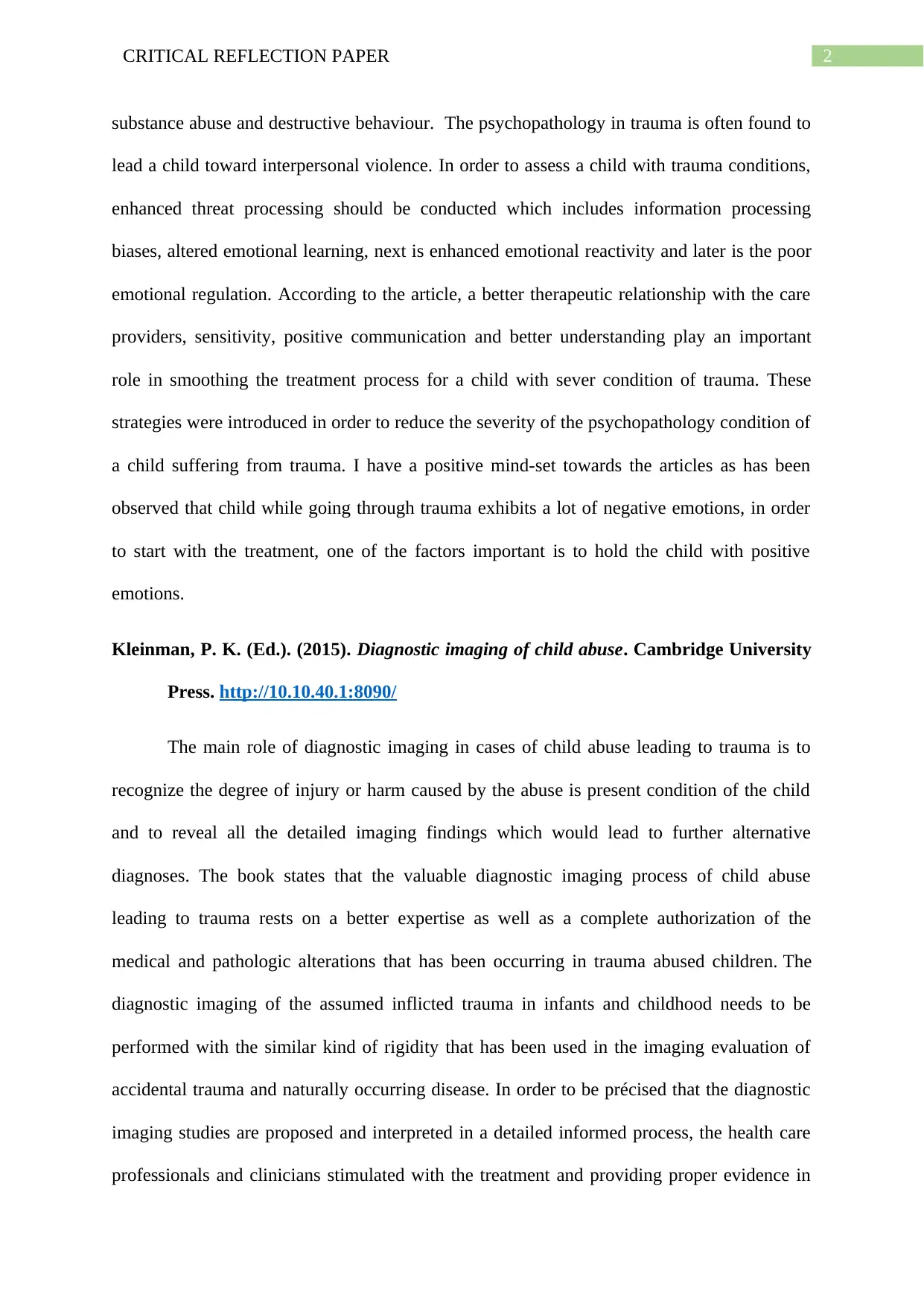
2CRITICAL REFLECTION PAPER
substance abuse and destructive behaviour. The psychopathology in trauma is often found to
lead a child toward interpersonal violence. In order to assess a child with trauma conditions,
enhanced threat processing should be conducted which includes information processing
biases, altered emotional learning, next is enhanced emotional reactivity and later is the poor
emotional regulation. According to the article, a better therapeutic relationship with the care
providers, sensitivity, positive communication and better understanding play an important
role in smoothing the treatment process for a child with sever condition of trauma. These
strategies were introduced in order to reduce the severity of the psychopathology condition of
a child suffering from trauma. I have a positive mind-set towards the articles as has been
observed that child while going through trauma exhibits a lot of negative emotions, in order
to start with the treatment, one of the factors important is to hold the child with positive
emotions.
Kleinman, P. K. (Ed.). (2015). Diagnostic imaging of child abuse. Cambridge University
Press. http://10.10.40.1:8090/
The main role of diagnostic imaging in cases of child abuse leading to trauma is to
recognize the degree of injury or harm caused by the abuse is present condition of the child
and to reveal all the detailed imaging findings which would lead to further alternative
diagnoses. The book states that the valuable diagnostic imaging process of child abuse
leading to trauma rests on a better expertise as well as a complete authorization of the
medical and pathologic alterations that has been occurring in trauma abused children. The
diagnostic imaging of the assumed inflicted trauma in infants and childhood needs to be
performed with the similar kind of rigidity that has been used in the imaging evaluation of
accidental trauma and naturally occurring disease. In order to be précised that the diagnostic
imaging studies are proposed and interpreted in a detailed informed process, the health care
professionals and clinicians stimulated with the treatment and providing proper evidence in
substance abuse and destructive behaviour. The psychopathology in trauma is often found to
lead a child toward interpersonal violence. In order to assess a child with trauma conditions,
enhanced threat processing should be conducted which includes information processing
biases, altered emotional learning, next is enhanced emotional reactivity and later is the poor
emotional regulation. According to the article, a better therapeutic relationship with the care
providers, sensitivity, positive communication and better understanding play an important
role in smoothing the treatment process for a child with sever condition of trauma. These
strategies were introduced in order to reduce the severity of the psychopathology condition of
a child suffering from trauma. I have a positive mind-set towards the articles as has been
observed that child while going through trauma exhibits a lot of negative emotions, in order
to start with the treatment, one of the factors important is to hold the child with positive
emotions.
Kleinman, P. K. (Ed.). (2015). Diagnostic imaging of child abuse. Cambridge University
Press. http://10.10.40.1:8090/
The main role of diagnostic imaging in cases of child abuse leading to trauma is to
recognize the degree of injury or harm caused by the abuse is present condition of the child
and to reveal all the detailed imaging findings which would lead to further alternative
diagnoses. The book states that the valuable diagnostic imaging process of child abuse
leading to trauma rests on a better expertise as well as a complete authorization of the
medical and pathologic alterations that has been occurring in trauma abused children. The
diagnostic imaging of the assumed inflicted trauma in infants and childhood needs to be
performed with the similar kind of rigidity that has been used in the imaging evaluation of
accidental trauma and naturally occurring disease. In order to be précised that the diagnostic
imaging studies are proposed and interpreted in a detailed informed process, the health care
professionals and clinicians stimulated with the treatment and providing proper evidence in
⊘ This is a preview!⊘
Do you want full access?
Subscribe today to unlock all pages.

Trusted by 1+ million students worldwide
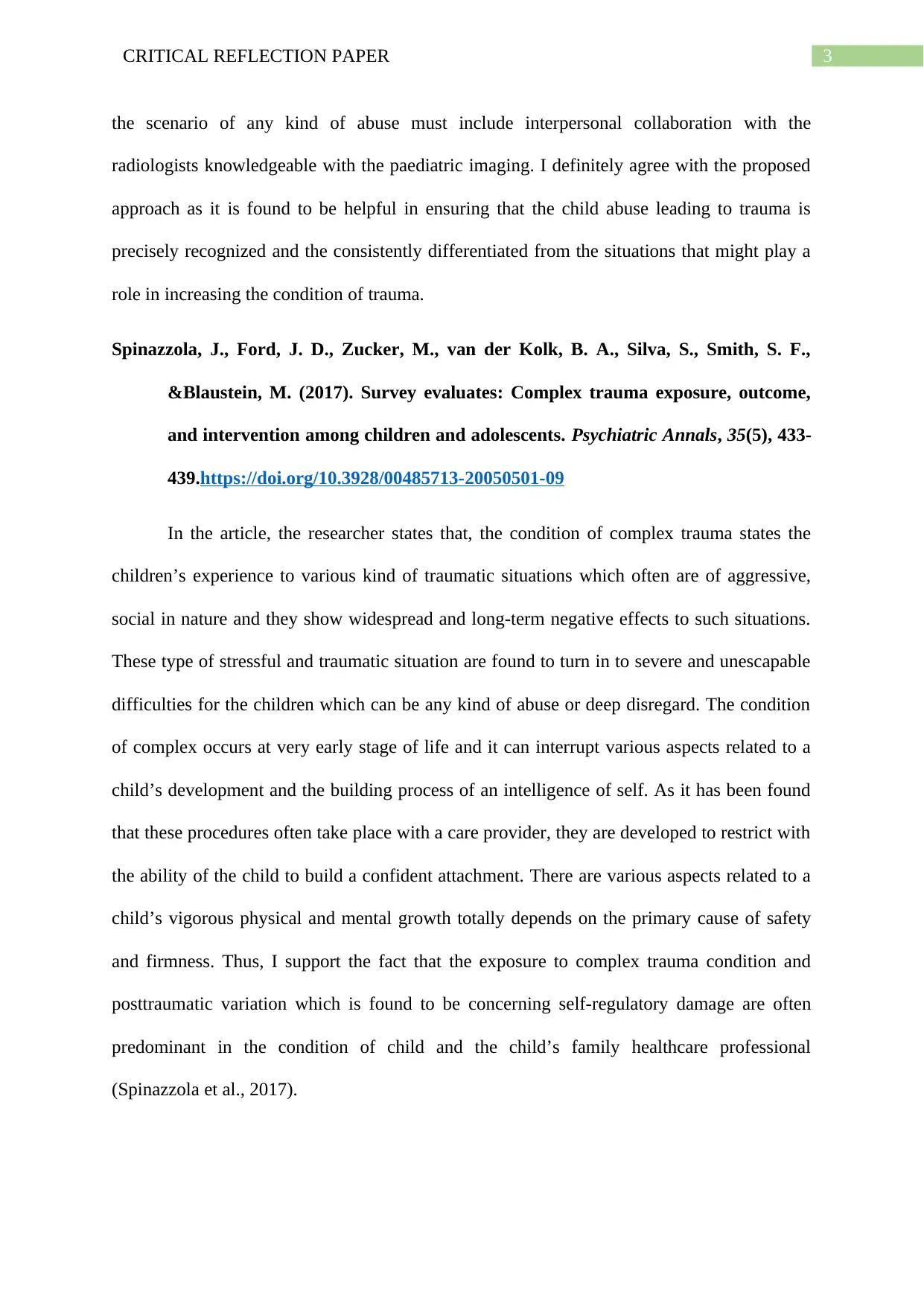
3CRITICAL REFLECTION PAPER
the scenario of any kind of abuse must include interpersonal collaboration with the
radiologists knowledgeable with the paediatric imaging. I definitely agree with the proposed
approach as it is found to be helpful in ensuring that the child abuse leading to trauma is
precisely recognized and the consistently differentiated from the situations that might play a
role in increasing the condition of trauma.
Spinazzola, J., Ford, J. D., Zucker, M., van der Kolk, B. A., Silva, S., Smith, S. F.,
&Blaustein, M. (2017). Survey evaluates: Complex trauma exposure, outcome,
and intervention among children and adolescents. Psychiatric Annals, 35(5), 433-
439.https://doi.org/10.3928/00485713-20050501-09
In the article, the researcher states that, the condition of complex trauma states the
children’s experience to various kind of traumatic situations which often are of aggressive,
social in nature and they show widespread and long-term negative effects to such situations.
These type of stressful and traumatic situation are found to turn in to severe and unescapable
difficulties for the children which can be any kind of abuse or deep disregard. The condition
of complex occurs at very early stage of life and it can interrupt various aspects related to a
child’s development and the building process of an intelligence of self. As it has been found
that these procedures often take place with a care provider, they are developed to restrict with
the ability of the child to build a confident attachment. There are various aspects related to a
child’s vigorous physical and mental growth totally depends on the primary cause of safety
and firmness. Thus, I support the fact that the exposure to complex trauma condition and
posttraumatic variation which is found to be concerning self-regulatory damage are often
predominant in the condition of child and the child’s family healthcare professional
(Spinazzola et al., 2017).
the scenario of any kind of abuse must include interpersonal collaboration with the
radiologists knowledgeable with the paediatric imaging. I definitely agree with the proposed
approach as it is found to be helpful in ensuring that the child abuse leading to trauma is
precisely recognized and the consistently differentiated from the situations that might play a
role in increasing the condition of trauma.
Spinazzola, J., Ford, J. D., Zucker, M., van der Kolk, B. A., Silva, S., Smith, S. F.,
&Blaustein, M. (2017). Survey evaluates: Complex trauma exposure, outcome,
and intervention among children and adolescents. Psychiatric Annals, 35(5), 433-
439.https://doi.org/10.3928/00485713-20050501-09
In the article, the researcher states that, the condition of complex trauma states the
children’s experience to various kind of traumatic situations which often are of aggressive,
social in nature and they show widespread and long-term negative effects to such situations.
These type of stressful and traumatic situation are found to turn in to severe and unescapable
difficulties for the children which can be any kind of abuse or deep disregard. The condition
of complex occurs at very early stage of life and it can interrupt various aspects related to a
child’s development and the building process of an intelligence of self. As it has been found
that these procedures often take place with a care provider, they are developed to restrict with
the ability of the child to build a confident attachment. There are various aspects related to a
child’s vigorous physical and mental growth totally depends on the primary cause of safety
and firmness. Thus, I support the fact that the exposure to complex trauma condition and
posttraumatic variation which is found to be concerning self-regulatory damage are often
predominant in the condition of child and the child’s family healthcare professional
(Spinazzola et al., 2017).
Paraphrase This Document
Need a fresh take? Get an instant paraphrase of this document with our AI Paraphraser
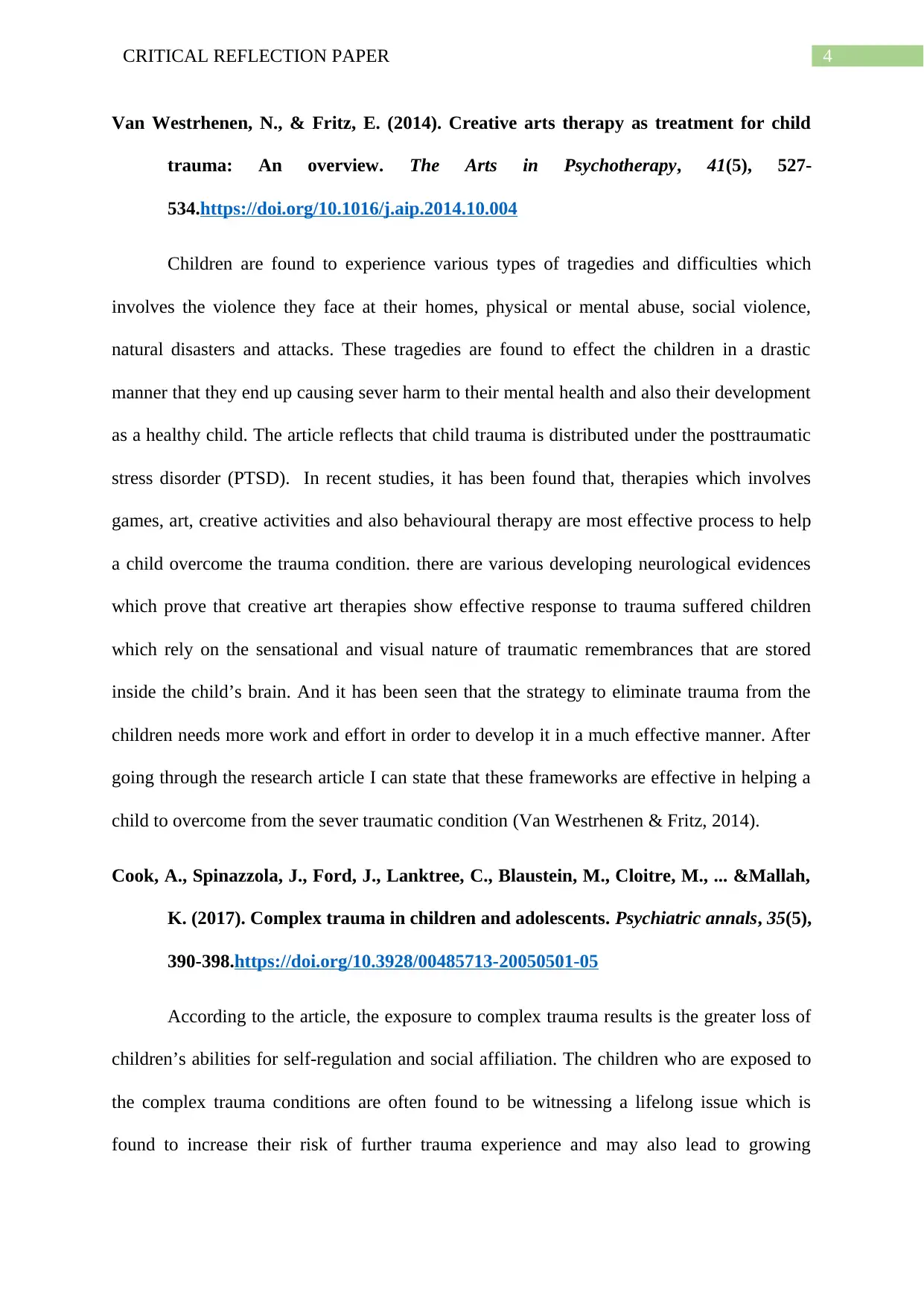
4CRITICAL REFLECTION PAPER
Van Westrhenen, N., & Fritz, E. (2014). Creative arts therapy as treatment for child
trauma: An overview. The Arts in Psychotherapy, 41(5), 527-
534.https://doi.org/10.1016/j.aip.2014.10.004
Children are found to experience various types of tragedies and difficulties which
involves the violence they face at their homes, physical or mental abuse, social violence,
natural disasters and attacks. These tragedies are found to effect the children in a drastic
manner that they end up causing sever harm to their mental health and also their development
as a healthy child. The article reflects that child trauma is distributed under the posttraumatic
stress disorder (PTSD). In recent studies, it has been found that, therapies which involves
games, art, creative activities and also behavioural therapy are most effective process to help
a child overcome the trauma condition. there are various developing neurological evidences
which prove that creative art therapies show effective response to trauma suffered children
which rely on the sensational and visual nature of traumatic remembrances that are stored
inside the child’s brain. And it has been seen that the strategy to eliminate trauma from the
children needs more work and effort in order to develop it in a much effective manner. After
going through the research article I can state that these frameworks are effective in helping a
child to overcome from the sever traumatic condition (Van Westrhenen & Fritz, 2014).
Cook, A., Spinazzola, J., Ford, J., Lanktree, C., Blaustein, M., Cloitre, M., ... &Mallah,
K. (2017). Complex trauma in children and adolescents. Psychiatric annals, 35(5),
390-398.https://doi.org/10.3928/00485713-20050501-05
According to the article, the exposure to complex trauma results is the greater loss of
children’s abilities for self-regulation and social affiliation. The children who are exposed to
the complex trauma conditions are often found to be witnessing a lifelong issue which is
found to increase their risk of further trauma experience and may also lead to growing
Van Westrhenen, N., & Fritz, E. (2014). Creative arts therapy as treatment for child
trauma: An overview. The Arts in Psychotherapy, 41(5), 527-
534.https://doi.org/10.1016/j.aip.2014.10.004
Children are found to experience various types of tragedies and difficulties which
involves the violence they face at their homes, physical or mental abuse, social violence,
natural disasters and attacks. These tragedies are found to effect the children in a drastic
manner that they end up causing sever harm to their mental health and also their development
as a healthy child. The article reflects that child trauma is distributed under the posttraumatic
stress disorder (PTSD). In recent studies, it has been found that, therapies which involves
games, art, creative activities and also behavioural therapy are most effective process to help
a child overcome the trauma condition. there are various developing neurological evidences
which prove that creative art therapies show effective response to trauma suffered children
which rely on the sensational and visual nature of traumatic remembrances that are stored
inside the child’s brain. And it has been seen that the strategy to eliminate trauma from the
children needs more work and effort in order to develop it in a much effective manner. After
going through the research article I can state that these frameworks are effective in helping a
child to overcome from the sever traumatic condition (Van Westrhenen & Fritz, 2014).
Cook, A., Spinazzola, J., Ford, J., Lanktree, C., Blaustein, M., Cloitre, M., ... &Mallah,
K. (2017). Complex trauma in children and adolescents. Psychiatric annals, 35(5),
390-398.https://doi.org/10.3928/00485713-20050501-05
According to the article, the exposure to complex trauma results is the greater loss of
children’s abilities for self-regulation and social affiliation. The children who are exposed to
the complex trauma conditions are often found to be witnessing a lifelong issue which is
found to increase their risk of further trauma experience and may also lead to growing
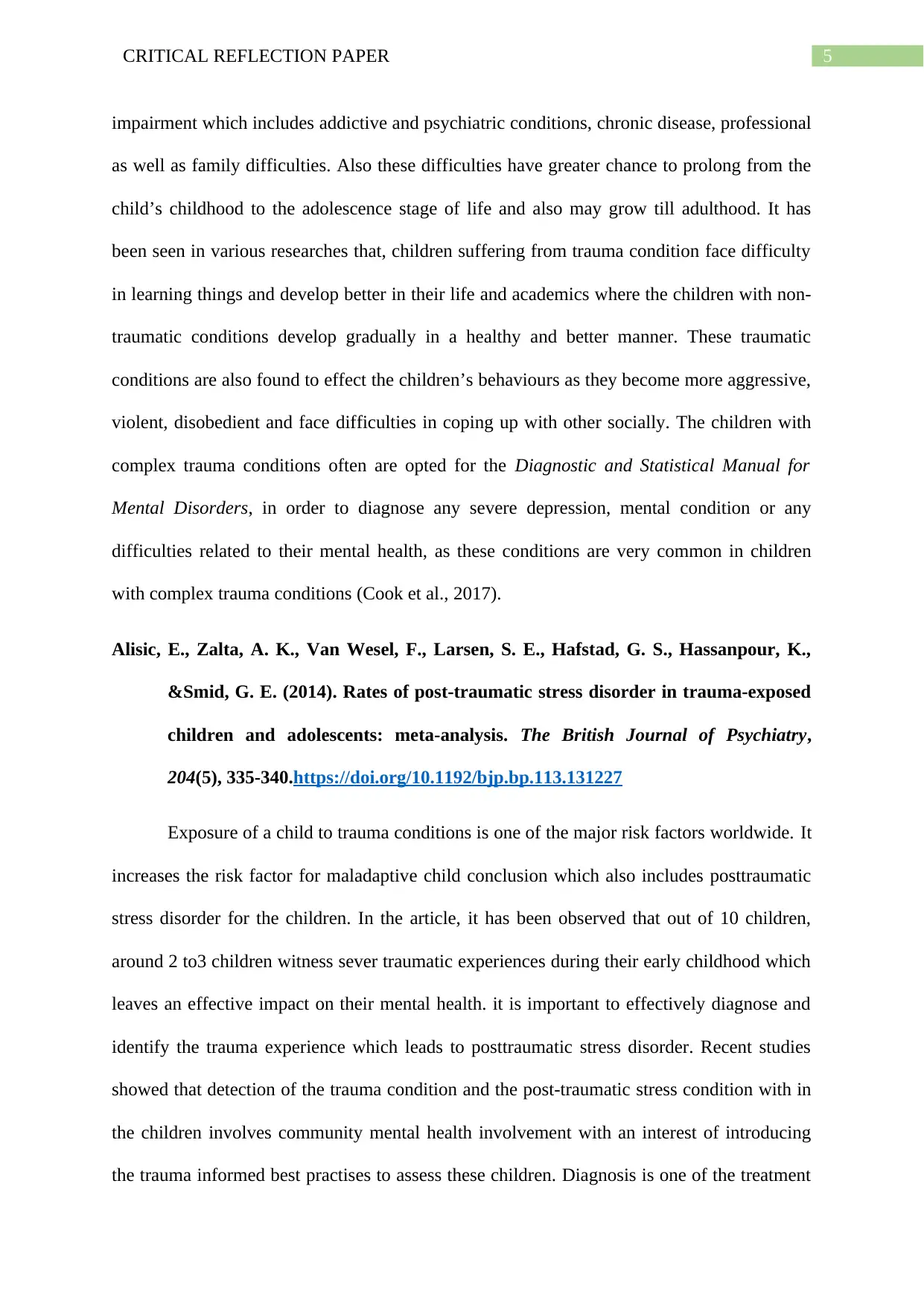
5CRITICAL REFLECTION PAPER
impairment which includes addictive and psychiatric conditions, chronic disease, professional
as well as family difficulties. Also these difficulties have greater chance to prolong from the
child’s childhood to the adolescence stage of life and also may grow till adulthood. It has
been seen in various researches that, children suffering from trauma condition face difficulty
in learning things and develop better in their life and academics where the children with non-
traumatic conditions develop gradually in a healthy and better manner. These traumatic
conditions are also found to effect the children’s behaviours as they become more aggressive,
violent, disobedient and face difficulties in coping up with other socially. The children with
complex trauma conditions often are opted for the Diagnostic and Statistical Manual for
Mental Disorders, in order to diagnose any severe depression, mental condition or any
difficulties related to their mental health, as these conditions are very common in children
with complex trauma conditions (Cook et al., 2017).
Alisic, E., Zalta, A. K., Van Wesel, F., Larsen, S. E., Hafstad, G. S., Hassanpour, K.,
&Smid, G. E. (2014). Rates of post-traumatic stress disorder in trauma-exposed
children and adolescents: meta-analysis. The British Journal of Psychiatry,
204(5), 335-340.https://doi.org/10.1192/bjp.bp.113.131227
Exposure of a child to trauma conditions is one of the major risk factors worldwide. It
increases the risk factor for maladaptive child conclusion which also includes posttraumatic
stress disorder for the children. In the article, it has been observed that out of 10 children,
around 2 to3 children witness sever traumatic experiences during their early childhood which
leaves an effective impact on their mental health. it is important to effectively diagnose and
identify the trauma experience which leads to posttraumatic stress disorder. Recent studies
showed that detection of the trauma condition and the post-traumatic stress condition with in
the children involves community mental health involvement with an interest of introducing
the trauma informed best practises to assess these children. Diagnosis is one of the treatment
impairment which includes addictive and psychiatric conditions, chronic disease, professional
as well as family difficulties. Also these difficulties have greater chance to prolong from the
child’s childhood to the adolescence stage of life and also may grow till adulthood. It has
been seen in various researches that, children suffering from trauma condition face difficulty
in learning things and develop better in their life and academics where the children with non-
traumatic conditions develop gradually in a healthy and better manner. These traumatic
conditions are also found to effect the children’s behaviours as they become more aggressive,
violent, disobedient and face difficulties in coping up with other socially. The children with
complex trauma conditions often are opted for the Diagnostic and Statistical Manual for
Mental Disorders, in order to diagnose any severe depression, mental condition or any
difficulties related to their mental health, as these conditions are very common in children
with complex trauma conditions (Cook et al., 2017).
Alisic, E., Zalta, A. K., Van Wesel, F., Larsen, S. E., Hafstad, G. S., Hassanpour, K.,
&Smid, G. E. (2014). Rates of post-traumatic stress disorder in trauma-exposed
children and adolescents: meta-analysis. The British Journal of Psychiatry,
204(5), 335-340.https://doi.org/10.1192/bjp.bp.113.131227
Exposure of a child to trauma conditions is one of the major risk factors worldwide. It
increases the risk factor for maladaptive child conclusion which also includes posttraumatic
stress disorder for the children. In the article, it has been observed that out of 10 children,
around 2 to3 children witness sever traumatic experiences during their early childhood which
leaves an effective impact on their mental health. it is important to effectively diagnose and
identify the trauma experience which leads to posttraumatic stress disorder. Recent studies
showed that detection of the trauma condition and the post-traumatic stress condition with in
the children involves community mental health involvement with an interest of introducing
the trauma informed best practises to assess these children. Diagnosis is one of the treatment
⊘ This is a preview!⊘
Do you want full access?
Subscribe today to unlock all pages.

Trusted by 1+ million students worldwide
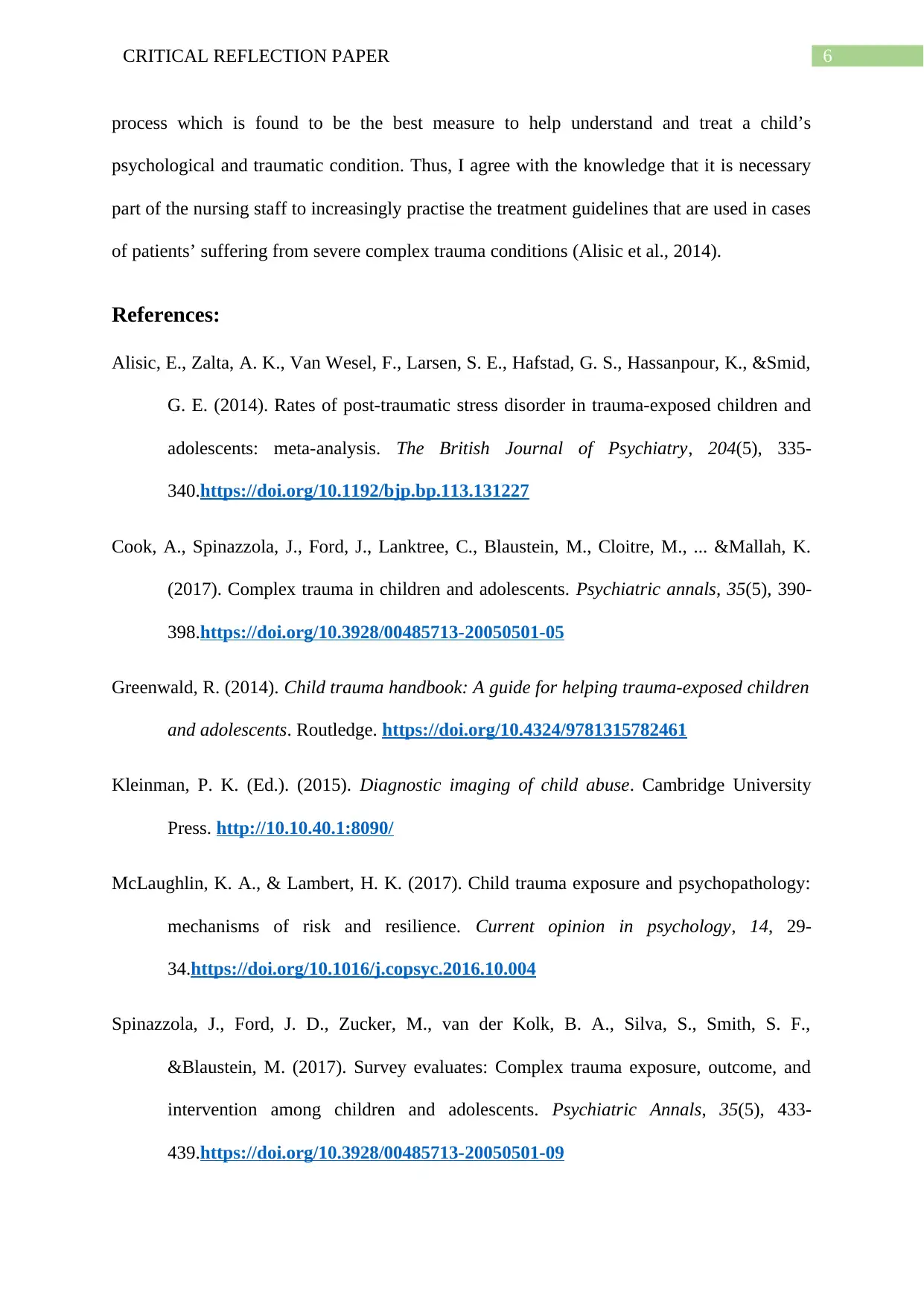
6CRITICAL REFLECTION PAPER
process which is found to be the best measure to help understand and treat a child’s
psychological and traumatic condition. Thus, I agree with the knowledge that it is necessary
part of the nursing staff to increasingly practise the treatment guidelines that are used in cases
of patients’ suffering from severe complex trauma conditions (Alisic et al., 2014).
References:
Alisic, E., Zalta, A. K., Van Wesel, F., Larsen, S. E., Hafstad, G. S., Hassanpour, K., &Smid,
G. E. (2014). Rates of post-traumatic stress disorder in trauma-exposed children and
adolescents: meta-analysis. The British Journal of Psychiatry, 204(5), 335-
340.https://doi.org/10.1192/bjp.bp.113.131227
Cook, A., Spinazzola, J., Ford, J., Lanktree, C., Blaustein, M., Cloitre, M., ... &Mallah, K.
(2017). Complex trauma in children and adolescents. Psychiatric annals, 35(5), 390-
398.https://doi.org/10.3928/00485713-20050501-05
Greenwald, R. (2014). Child trauma handbook: A guide for helping trauma-exposed children
and adolescents. Routledge. https://doi.org/10.4324/9781315782461
Kleinman, P. K. (Ed.). (2015). Diagnostic imaging of child abuse. Cambridge University
Press. http://10.10.40.1:8090/
McLaughlin, K. A., & Lambert, H. K. (2017). Child trauma exposure and psychopathology:
mechanisms of risk and resilience. Current opinion in psychology, 14, 29-
34.https://doi.org/10.1016/j.copsyc.2016.10.004
Spinazzola, J., Ford, J. D., Zucker, M., van der Kolk, B. A., Silva, S., Smith, S. F.,
&Blaustein, M. (2017). Survey evaluates: Complex trauma exposure, outcome, and
intervention among children and adolescents. Psychiatric Annals, 35(5), 433-
439.https://doi.org/10.3928/00485713-20050501-09
process which is found to be the best measure to help understand and treat a child’s
psychological and traumatic condition. Thus, I agree with the knowledge that it is necessary
part of the nursing staff to increasingly practise the treatment guidelines that are used in cases
of patients’ suffering from severe complex trauma conditions (Alisic et al., 2014).
References:
Alisic, E., Zalta, A. K., Van Wesel, F., Larsen, S. E., Hafstad, G. S., Hassanpour, K., &Smid,
G. E. (2014). Rates of post-traumatic stress disorder in trauma-exposed children and
adolescents: meta-analysis. The British Journal of Psychiatry, 204(5), 335-
340.https://doi.org/10.1192/bjp.bp.113.131227
Cook, A., Spinazzola, J., Ford, J., Lanktree, C., Blaustein, M., Cloitre, M., ... &Mallah, K.
(2017). Complex trauma in children and adolescents. Psychiatric annals, 35(5), 390-
398.https://doi.org/10.3928/00485713-20050501-05
Greenwald, R. (2014). Child trauma handbook: A guide for helping trauma-exposed children
and adolescents. Routledge. https://doi.org/10.4324/9781315782461
Kleinman, P. K. (Ed.). (2015). Diagnostic imaging of child abuse. Cambridge University
Press. http://10.10.40.1:8090/
McLaughlin, K. A., & Lambert, H. K. (2017). Child trauma exposure and psychopathology:
mechanisms of risk and resilience. Current opinion in psychology, 14, 29-
34.https://doi.org/10.1016/j.copsyc.2016.10.004
Spinazzola, J., Ford, J. D., Zucker, M., van der Kolk, B. A., Silva, S., Smith, S. F.,
&Blaustein, M. (2017). Survey evaluates: Complex trauma exposure, outcome, and
intervention among children and adolescents. Psychiatric Annals, 35(5), 433-
439.https://doi.org/10.3928/00485713-20050501-09
Paraphrase This Document
Need a fresh take? Get an instant paraphrase of this document with our AI Paraphraser

7CRITICAL REFLECTION PAPER
Van Westrhenen, N., & Fritz, E. (2014). Creative arts therapy as treatment for child trauma:
An overview. The Arts in Psychotherapy, 41(5), 527-
534.https://doi.org/10.1016/j.aip.2014.10.004
Van Westrhenen, N., & Fritz, E. (2014). Creative arts therapy as treatment for child trauma:
An overview. The Arts in Psychotherapy, 41(5), 527-
534.https://doi.org/10.1016/j.aip.2014.10.004
1 out of 8
Related Documents
Your All-in-One AI-Powered Toolkit for Academic Success.
+13062052269
info@desklib.com
Available 24*7 on WhatsApp / Email
![[object Object]](/_next/static/media/star-bottom.7253800d.svg)
Unlock your academic potential
Copyright © 2020–2025 A2Z Services. All Rights Reserved. Developed and managed by ZUCOL.





